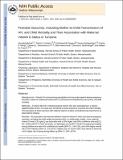| dc.contributor.author | Mehta, Saurabh | |
| dc.contributor.author | Hunter, David J. | |
| dc.contributor.author | Mugusi, Ferdinand M. | |
| dc.contributor.author | Spiegelman, Donna Lynn | |
| dc.contributor.author | Manji, Karim P. | |
| dc.contributor.author | Giovannucci, Edward L. | |
| dc.contributor.author | Hertzmark, Ellen | |
| dc.contributor.author | Msamanga, Gernard I. | |
| dc.contributor.author | Fawzi, Wafaie W. | |
| dc.date.accessioned | 2016-05-05T19:48:10Z | |
| dc.date.issued | 2009 | |
| dc.identifier.citation | Mehta, Saurabh, David J. Hunter, Ferdinand M. Mugusi, Donna Spiegelman, Karim P. Manji, Edward L. Giovannucci, Ellen Hertzmark, Gernard I. Msamanga, and Wafaie W. Fawzi. 2009. “Perinatal Outcomes, Including Mother‐to‐Child Transmission of HIV, and Child Mortality and Their Association with Maternal Vitamin D Status in Tanzania.” J INFECT DIS 200 (7) (October): 1022–1030. doi:10.1086/605699. | en_US |
| dc.identifier.issn | 0022-1899 | en_US |
| dc.identifier.uri | http://nrs.harvard.edu/urn-3:HUL.InstRepos:26951082 | |
| dc.description.abstract | Background
Vitamin D is a strong immunomodulator and may protect against adverse pregnancy outcomes, mother-to-child transmission (MTCT) of human immunodeficiency virus (HIV), and child mortality.
Methods
A total of 884 HIV-infected pregnant women who were participating in a vitamin supplementation trial in Tanzania were monitored to assess pregnancy outcomes and child mortality. The association of these outcomes with maternal vitamin D status at enrollment was examined in an observational analysis.
Results
No association was observed between maternal vitamin D status and adverse pregnancy outcomes, including low birth weight and preterm birth. In multivariate models, a low maternal vitamin D level (<32 ng/mL) was associated with a 50% higher risk (95% confidence interval [CI], 2%–120%) of MTCT of HIV at 6 weeks, a 2-fold higher risk of MTCT of HIV through breast-feeding among children who were HIV uninfected at 6 weeks (95% CI, 1.08–3.82), and a 46% higher overall risk of HIV infection (95% CI, 11%–91%). Children born to women with a low vitamin D level had a 61% higher risk of dying during follow-up (95% CI, 25%–107%).
Conclusions
If found to be efficacious in randomized trials, vitamin D supplementation could prove to be an inexpensive method of reducing the burden of HIV infection and death among children, particularly in resource-limited settings. | en_US |
| dc.language.iso | en_US | en_US |
| dc.publisher | Oxford University Press (OUP) | en_US |
| dc.relation.isversionof | doi:10.1086/605699 | en_US |
| dc.relation.hasversion | http://www.ncbi.nlm.nih.gov/pmc/articles/PMC2758703/ | en_US |
| dash.license | LAA | |
| dc.title | Perinatal Outcomes, Including Mother‐to‐Child Transmission of HIV, and Child Mortality and Their Association with Maternal Vitamin D Status in Tanzania | en_US |
| dc.type | Journal Article | en_US |
| dc.description.version | Accepted Manuscript | en_US |
| dc.relation.journal | The Journal of Infectious Diseases | en_US |
| dash.depositing.author | Fawzi, Wafaie W. | |
| dc.date.available | 2016-05-05T19:48:10Z | |
| dc.identifier.doi | 10.1086/605699 | * |
| dash.contributor.affiliated | Hertzmark, Ellen | |
| dash.contributor.affiliated | Hunter, David | |
| dash.contributor.affiliated | Spiegelman, Donna | |
| dash.contributor.affiliated | Giovannucci, Edward | |
| dash.contributor.affiliated | Fawzi, Wafaie | |


